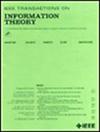Fundamental Limits of Covert Communication Over Classical-Quantum Channels
IF 2.2
3区 计算机科学
Q3 COMPUTER SCIENCE, INFORMATION SYSTEMS
引用次数: 0
Abstract
We investigate covert communication over general memoryless classical-quantum channels with fixed finite-size input alphabets. We show that the square root law (SRL) governs covert communication in this setting when product a of经典量子信道隐蔽通信的基本限制
我们研究了具有固定有限大小输入字母表的一般无记忆经典量子信道上的隐蔽通信。我们证明,当使用 n 个输入状态的乘积 a 时,平方根定律(SRL)在这种情况下支配着隐蔽通信: 其中 $L_{\mathrm { SRL}}\sqrt {n}+o(\sqrt {n})$ 是一个与信道相关的常数,我们称之为隐蔽容量。我们还证明,确保隐蔽性需要通信双方在传输前共享 $J_{\mathrm { SRL}}\sqrt {n}+o(\sqrt {n})$比特秘钥,其中 $J_{\mathrm { SRL}}\geq 0$ 是一个与信道相关的常数。我们假设有一个强大的量子对手,可以对所有 n 个信道使用进行任意联合(纠缠)测量。我们确定了 $L_{\mathrm { SRL}}$ 和 $J_{\mathrm { SRL}}$ 的单字母表达式,并建立了 $J_{\mathrm { SRL}}=0$ 时的条件(即不需要预共享密钥)。最后,我们评估了不受 SRL 约束的隐蔽通信场景。
本文章由计算机程序翻译,如有差异,请以英文原文为准。
求助全文
约1分钟内获得全文
求助全文
来源期刊

IEEE Transactions on Information Theory
工程技术-工程:电子与电气
CiteScore
5.70
自引率
20.00%
发文量
514
审稿时长
12 months
期刊介绍:
The IEEE Transactions on Information Theory is a journal that publishes theoretical and experimental papers concerned with the transmission, processing, and utilization of information. The boundaries of acceptable subject matter are intentionally not sharply delimited. Rather, it is hoped that as the focus of research activity changes, a flexible policy will permit this Transactions to follow suit. Current appropriate topics are best reflected by recent Tables of Contents; they are summarized in the titles of editorial areas that appear on the inside front cover.
 求助内容:
求助内容: 应助结果提醒方式:
应助结果提醒方式:


